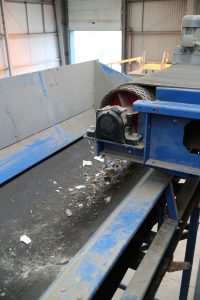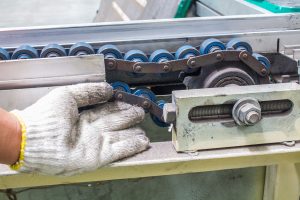With conveyor belts operating at maximum output on a routine basis, there’s no question as to whether the many moving parts in your system will eventually run into issues. That’s why it’s more important than ever to keep a close eye on your system to make sure everything is running smoothly and perform regular conveyor belt maintenance.
Since one seemingly small problem has the potential to create a greater impact on the entire system, an unaddressed issue could cause costly downtime, repairs, and even threaten the safety of your workers. To help you avoid these situations, we’ve put together a list of some of the most common issues to look for during your conveyor belt troubleshooting and solutions for each instance.
Belt Slippage
One of the most common causes behind conveyor belt failure happens when there is either too much or too little tension in the conveyor belting. This loss of tension can cause belt slippage, which can lead to more serious issues, including costly belt or motor failure.


Common Causes:
- Insufficient traction between the belt and pulley
- Poor installation or worn lagging on the head drive pulley
- A load that exceeds the weight limit of the belt and its pulleys
- Sticking idlers
Common Solutions:
- Lag the drive pulley
- Check for worn heads or buildup and continue to do preventative conveyor belt maintenance to catch early signs of wear
- Ensure objects/material are within the weight range or consider upgrading your system
- Clear the idlers and increase regular maintenance and/or lubrication
Conveyor Belt Tracking Issues
From a belt running to one side of the conveyor to a belt running off at the tail or head pulley, conveyor belt mistracking typically means that your system has shifted out of alignment. This can cause several different issues, ranging from uneven belt wear to shutting down the whole system.
Conveyor belt troubleshooting can help you identify the issue and locate where it’s occurring in your system. Here are some potential factors you’ll want to look out for:
Common Causes:
- A crooked conveyor frame or structure
- A belt splice or joint that is not properly cut
- Idlers or pulleys that are out-of-square with the center line of the belt
- Material buildup on the belt, idlers, and/or pulleys
Commons Solutions:
- Take a look at the framework from all areas and check that the frame is level and square; straighten the affected area
- To correct the tracking errors, remove the affected splice and re-splice that section of the belt
- Readjust the idlers of the pulleys in the affected area and ensure they’re providing enough tension to the belt
- Remove the accumulation and set in place a plan for improved/regular maintenance to keep the system running smoothly
Material Carryback
More often than not, material carryback is behind most conveyor belt troubleshooting issues. Material carryback refers to the material that didn’t discharge properly and has built up on the belt itself and gets carried back on the return. This material can also fall off of the belt and cause accumulation underneath the belt, which can have a negative impact for the rollers and pulleys in your system.


Common Causes:
- Low-quality scrapers
- Scrapers installed incorrectly
- Material spillage and buildup
Commons Solutions:
- Invest in a high-quality cleaning system with effective primary and secondary scrapers
- Ensure scraper blades press close to the belt and prevent material buildup; re-install the scrapers properly
- Improve loading and transfer conditions
Belt Tears & Splice Separation
For most operations, especially applications that handle more abrasive material, tears and perforations in the belt can occur and are often difficult to prevent. Conveyor belt failure due to splice separation; however, can be avoided with the proper splice procedure and by reducing stress and tension on the belt.
Both belt tears and splice separation can be detrimental to your production with unwanted downtime, if earlier signs are not addressed in time. Here are some of the key factors to keep an eye on:
Common Causes:
- Belt improperly spliced
- Poor transition between troughed belt and terminal pulleys
- Impact of the material on the belt
- Material buildup on the pulleys
Common Solutions:
- Re-splice the affected area
- Adjust the transitions
- Reduce the chute design to decrease impact and install impact idlers
- Remove material buildup from the pulleys and v-guide grooves
Seized Rollers
In conveyor belt troubleshooting, roller issues can be a source of belt misalignment. While rollers are typically made of stainless steel or aluminum that can provide exceptional durability, when seized, the rollers can develop sharp edges. These sharpened edges can not only pose a threat to the materials being conveyed, but also the safety of those working within the area. If you’re experiencing seized rollers, here are some common solutions: 

Common Causes:
- Dirt and debris buildup in the return rolls
- Stuck or misaligned rollers
Common Solutions:
- Remove accumulation and use cleaning devices and self-cleaning return rolls, as well as improve maintenance and lubrication
- Check for sharp edges on seized rollers and replace as needed; ensure rollers aren’t misaligned/causing mistracking and adjust as needed
Partner with IBT for Conveyor Belt Troubleshooting & Services
Have you come across a more complex problem in your conveyor belt troubleshooting or need further guidance on diagnosis or belt replacement? IBT’s Industrial Rubber Services team is here to help.
From onsite, full turn-key belt installation to vulcanization to conveyor belt maintenance, IBT’s Industrial Rubber Services team has decades of experience in providing solutions for applications across all industries. Reach out to our dedicated experts at the branch service center near you or fill out our contact form to discover how we can help you keep your system operating perfectly within motion.
If you know what conveyor belting parts you’re looking for, visit ShopIBT to purchase products directly!





